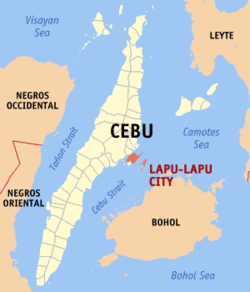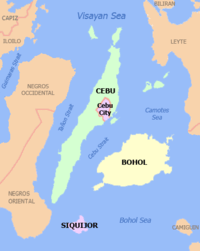Lapu-Lapu, Philippines
| Lapu-Lapu | ||
|---|---|---|
| Highly Urbanized City | ||
|
Aerial view over MEPZ–II | ||
| ||
| Nickname(s): Historic Resort City | ||
 Map of Central Visayas with Lapu-Lapu highlighted | ||
.svg.png) Lapu-Lapu Location within the Philippines | ||
| Coordinates: 10°19′N 123°57′E / 10.32°N 123.95°ECoordinates: 10°19′N 123°57′E / 10.32°N 123.95°E | ||
| Country | Philippines | |
| Region | Central Visayas (Region VII) | |
| Province | Cebu (geographically only) | |
| District | Lone district of Lapu‑Lapu | |
|
1730 17 June 1961 22 October 2009 | |
| Barangay |
30 (see § Barangays)
| |
| Government [1] | ||
| • Type | Sangguniang Panlungsod | |
| • Mayor | Paz Radaza (LP) | |
| • Vice mayor | Marcial Ycong | |
| • City Council |
Members
| |
| • Representative | Aileen Radaza | |
| Area[2] | ||
| • Total | 58.1 km2 (22.4 sq mi) | |
| Population (2015 census)[3] | ||
| • Total | 408,112 | |
| • Density | 7,000/km2 (18,000/sq mi) | |
| • Voter (2016)[4] | 188,815 | |
| Time zone | PST (UTC+8) | |
| ZIP code | 6015 | |
| IDD : area code | +63 (0)32 | |
| Income class | 1st class | |
| PSGC | 072226000 | |
| Website |
www | |
Lapu-Lapu, officially the City of Lapu-Lapu (Cebuano: Dakbayan sa Lapu-Lapu, Filipino: Lungsod ng Lapu-Lapu) and formerly called Opon, is a 1st city income class highly urbanized city in the region of Central Visayas, Cebu, Philippines. It is one of the cities that make up Metro Cebu in the Philippines. It is geographically located in the province of Cebu, administratively independent from the province but grouped under Cebu by the Philippine Statistics Authority. According to the 2015 census, it has a population of 408,112.[3] In the 2016 election, it had 188,815 registered voters.[4]
The city occupies Mactan Island, a few kilometers off the main island of Cebu. It also has some of the barangays under its jurisdiction on the Olango Island Group. The city is linked to Mandaue on mainland Cebu by the Mactan-Mandaue Bridge and Marcelo Fernan Bridge. Mactan-Cebu International Airport, the second busiest airport in the Philippines, is located in Lapu-Lapu.
History
In the 16th century Mactan Island was colonized by Spain. Augustinian friars founded the town of Opon in 1730 and it became a city in 1961. It was renamed after Datu Lapu-Lapu, the island's chieftain who defeated Portuguese explorer Ferdinand Magellan in 1521 in the Battle of Mactan, commemorated at the Lapu-Lapu shrine in Punta Engaño.
On 27 April 1521, Lapu-Lapu, a native chieftain, successfully repulsed the foreign invaders in Mactan. He defeated the Spanish troops and killed their leader, Ferdinand Magellan. The municipality of Opon was founded by the Augustinian missionaries in 1730. It was ceded to the Jesuits in 1737, and later restored to the Augustinians. When the Philippine Revolution spread to the Visayas in 1896, the people organized themselves into local revolutionary units.
During the Filipino-American War, a military government was established. The continued resistance of the people of Cebu prompted the American government to restore military control over the province on 17 July 1901. In 1905, Opon held its first municipal election and Pascual dela Serna was elected town president.
The presence of oil tanks in Opon made the town an object of Japanese raids a week after the outbreak of World War II in December 1941. The enemy planes succeeded in blowing up two of about fourteen oil tanks in Opon. A unit of the Kawaguchi Detachment of the Japanese Imperial Forces landed on the east coast of Cebu on 10 April 1942. Later, the resistance movement was organized by Colonel James M. Cushing, leader of the southern and central units, and Harry Fenton of the northern unit of the Cebu Resistance Movement.
The Victor II operations of the American Division led by Major General William Arnold landed in Cebu on 26 March 1945, and subsequently liberated the province.
Congressman Manuel A. Zosa, the representative of the Sixth District of Cebu, sponsored the Bill converting the former municipality of Opon into the present day city of Lapu-Lapu. This was the Republic Act 3134, known as the City Charter of Lapu-Lapu which was signed on 17 June 1961 by Philippine President Carlos P. Garcia. Lapu-Lapu was inaugurated on 31 December 1961, with Mariano Dimataga, the last municipal mayor, as the first city mayor.[5]
As a fast growing commercial city, some of its commercial and industrial firms are the General Milling Company, one of the largest in the country; the Cebu Shipyard and Engineering Works, pioneered by Dad Cleland; and the oil companies which resumed their operations after the war. The air flight in the city is served by the Mactan International Airport.
Historically, the city includes the site of the Battle of Mactan. On 1 August 1973, by virtue of Presidential Decree No. 2060, President Ferdinand Marcos declared the site of the battle a national shrine; the preservation, restoration and/or reconstruction of which shall be under the supervision and control of the National Historical Commission in collaboration with the Department of Tourism. Mactan is also the birthplace of Leonila Dimataga-Garcia, wife of Carlos P. Garcia, the fourth President of the Republic.
Barangays
Lapu-Lapu comprises 30 barangays:[2]
| PSGC | Barangay | Population | ±% p.a. | Area[2] | PD 2015 | ||||
|---|---|---|---|---|---|---|---|---|---|
| 2015[3] | 2010[6] | ha | acre | /km2 | /sq mi | ||||
| 072226001 | Agus | 3.9% | 15,767 | 8,185 | +13.30% | 211 | 521 | 7,500 | 19,000 |
| 072226002 | Babag | 5.6% | 22,756 | 17,721 | +4.88% | 307 | 759 | 7,400 | 19,000 |
| 072226003 | Bankal | 5.1% | 20,872 | 13,802 | +8.19% | 201 | 497 | 10,000 | 27,000 |
| 072226004 | Baring | 0.8% | 3,353 | 3,014 | +2.05% | 91 | 225 | 3,700 | 9,500 |
| 072226005 | Basak | 14.7% | 59,873 | 45,927 | +5.18% | 603 | 1,490 | 9,900 | 26,000 |
| 072226006 | Buaya | 3.9% | 16,072 | 12,123 | +5.52% | 271 | 670 | 5,900 | 15,000 |
| 072226007 | Calawisan | 2.8% | 11,454 | 8,433 | +6.00% | 957 | 2,365 | 1,200 | 3,100 |
| 072226008 | Canjulao | 3.2% | 13,245 | 11,471 | +2.78% | 156 | 385 | 8,500 | 22,000 |
| 072226011 | Caubian | 0.6% | 2,272 | 2,028 | +2.19% | ||||
| 072226009 | Cawoy | 0.5% | 1,837 | 1,629 | +2.31% | 42 | 104 | 4,400 | 11,000 |
| 072226010 | Cawhagan | 0.2% | 638 | 559 | +2.55% | ||||
| 072226012 | Gun-ob | 7.6% | 31,219 | 34,662 | −1.97% | ||||
| 072226013 | Ibo | 2.0% | 8,126 | 7,055 | +2.73% | ||||
| 072226014 | Looc | 3.9% | 16,016 | 14,073 | +2.49% | ||||
| 072226015 | Mactan | 8.2% | 33,465 | 29,262 | +2.59% | ||||
| 072226016 | Maribago | 4.1% | 16,591 | 12,064 | +6.25% | ||||
| 072226017 | Marigondon | 4.8% | 19,713 | 17,542 | +2.25% | ||||
| 072226018 | Pajac | 4.3% | 17,402 | 16,084 | +1.51% | ||||
| 072226019 | Pajo | 5.1% | 20,999 | 23,107 | −1.80% | ||||
| 072226020 | Pangan‑an | 0.5% | 2,070 | 1,767 | +3.06% | ||||
| 072226021 | Poblacion[lower-alpha 1] | 1.4% | 5,581 | 8,243 | −7.16% | ||||
| 072226022 | Punta Engaño | 2.1% | 8,753 | 7,106 | +4.05% | ||||
| 072226024 | Pusok | 7.1% | 28,810 | 26,568 | +1.55% | ||||
| 072226025 | Sabang | 1.5% | 6,091 | 5,603 | +1.60% | ||||
| 072226031 | San Vicente | 0.9% | 3,854 | 3,413 | +2.34% | ||||
| 072226026 | Santa Rosa | 1.1% | 4,302 | 3,934 | +1.72% | ||||
| 072226027 | Subabasbas | 1.5% | 6,288 | 5,457 | +2.74% | ||||
| 072226028 | Talima | 1.4% | 5,734 | 4,855 | +3.22% | ||||
| 072226029 | Tingo | 0.8% | 3,088 | 2,830 | +1.68% | ||||
| 072226030 | Tungasan | 0.5% | 1,871 | 1,950 | −0.78% | ||||
| Total | 408,112 | 350,467 | +2.94% | 5,810 | 14,357 | 7,000 | 18,000 | ||
Demographics
| Population census of Lapu-Lapu | |||||||||||||||||||||||||||||||
|---|---|---|---|---|---|---|---|---|---|---|---|---|---|---|---|---|---|---|---|---|---|---|---|---|---|---|---|---|---|---|---|
|
| ||||||||||||||||||||||||||||||
| Source: Philippine Statistics Office[3][6][7][8] | |||||||||||||||||||||||||||||||
In the 2016 election, it had 188,815 registered voters, meaning that 46% of the population are aged 18 and over.[4]
Transportation
Mactan-Cebu International Airport is located in Lapu-Lapu which connected to mainland Cebu via Marcelo Fernan Bridge and Mactan-Mandaue Bridge over the sea separating the Mactan island from the island of Cebu. The airport is the main gateway to Central Visayas serving international flights to Singapore, Hong Kong, South Korea, Japan, Taiwan and Russia. MCIA is the second busiest airport in the Philippines after Ninoy Aquino International Airport in Manila.
Gallery
- City Hall
 Poblacion (Opon)
Poblacion (Opon)- Muelle Osmeña
- Virgen de la Regla Church
 Magellan and Lapu-Lapu shrines
Magellan and Lapu-Lapu shrines
See also
Notes
- ↑ Part of the Poblacion barangay is still called Opon.
References
- ↑ "City". Quezon City, Philippines: Department of the Interior and Local Government. Retrieved 30 May 2013.
- 1 2 3 "Municipal: Lapu-Lapu, Philippines". PSGC Interactive. Quezon City, Philippines: Philippine Statistics Authority. Retrieved 8 January 2016.
- 1 2 3 4 "Region VII (CENTRAL VISAYAS)". Census of Population (2015): Total Population by Province, City, Municipality and Barangay (Report). PSA. Retrieved 20 June 2016.
- 1 2 3 "2016 National and Local Elections Statistics". Commission on Elections. 2016.
- ↑ About Lapu Lapu City
- 1 2 "Region VII (CENTRAL VISAYAS)". Census of Population and Housing (2010): Total Population by Province, City, Municipality and Barangay (Report). NSO. Retrieved 29 June 2016.
- ↑ "Region VII (CENTRAL VISAYAS)". Census of Population (1995, 2000 and 2007): Total Population by Province, City and Municipality (Report). NSO. Archived from the original on 24 June 2011.
- ↑ Gonzales 2004.
Sources
- Gonzales, Glenda R. (December 2004). "Metro Cebu: A Metropolitan Area in Need of Coordinative Body" (PDF). DISCUSSION PAPER. 2004-49. Philippine Institute for Development Studies. Retrieved 16 February 2016.
| Wikimedia Commons has media related to Lapu‑Lapu. |
External links
| Wikivoyage has a travel guide for Lapu–Lapu. |
 |
Mandaue | Mactan Channel | |
Camotes Sea |  |
| Cebu City | Mactan Channel | |
|||
| ||||
| | ||||
| Cordova | Cebu Strait |


